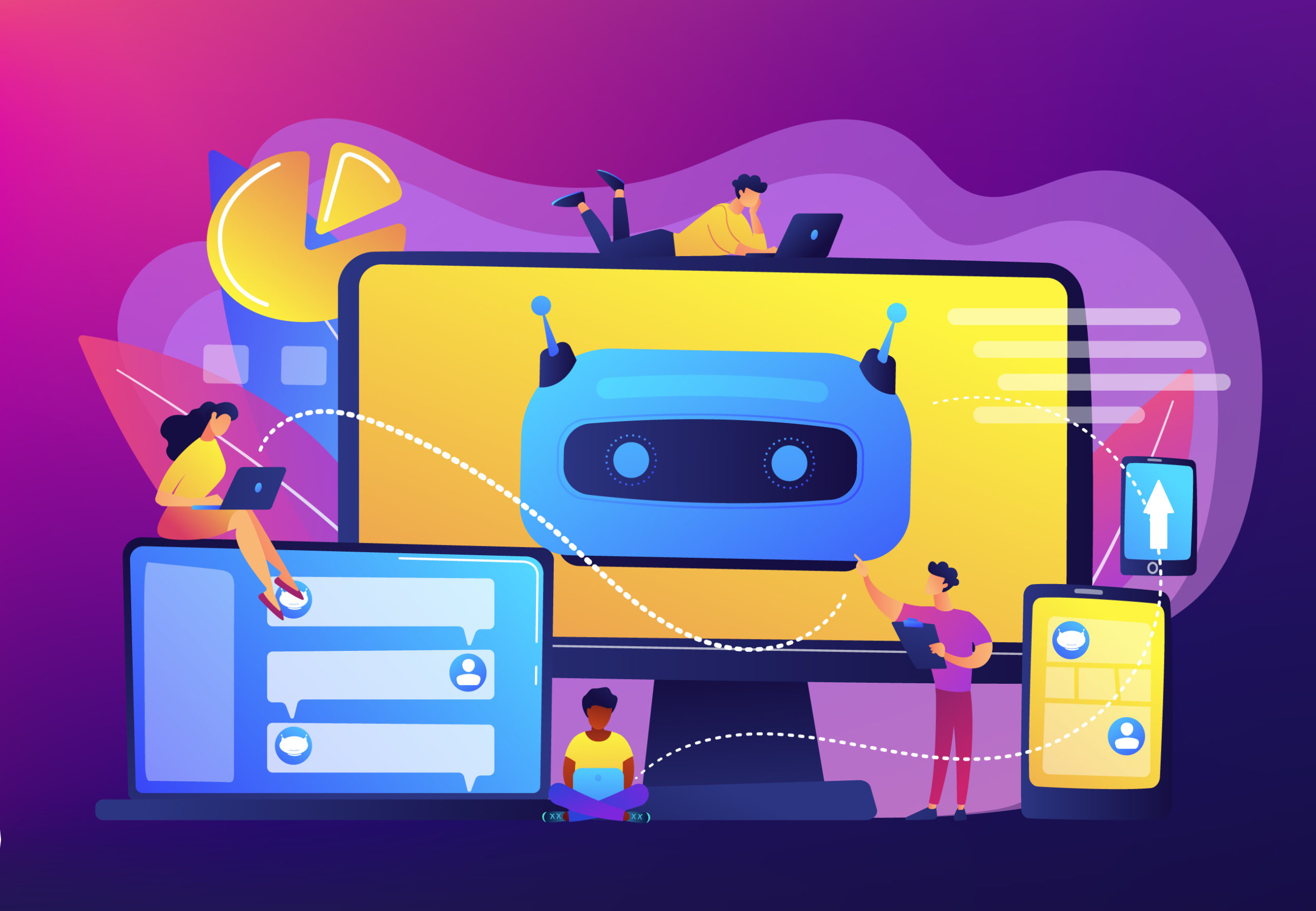Chances are, you’ve already interacted with numerous chatbots. But, for the sake of this article, chatbots are domain-specific conversational user interfaces that mimic chatting with another human to help and guide users.
The standard chatbot falls into the customer service or interaction categories. Customer service chatbots tend to be text-only and help customers with typical problems or inquiries. Interaction chatbots contribute additional functionality and help provide a service. Whether that be getting a quote or placing an order, they help users get something done.
Interaction bots tend to incorporate more visual elements, but on the leading edge of chatbot tech are visual chatbots: bots that can recognize elements in images, respond to images and create their own based on text.
These bots allow businesses to save time and money on agents, and it’s why 39% of chats between businesses and consumers involved a bot in 2023.
The problem is that chatbots are in a sort of intelligence limbo—some indistinguishable from the humans they replicate and others a bit more…lacking.
And when it comes down to it, your success with chatbots comes down to their ability to contribute to a great user experience.
How Chatbots Can Benefit UX
Chatbots can be an effective way to improve UX, and a better UX means higher conversion rates. Here are the main ways chatbots enhance the user experience:
Faster Response Times
Chatbots remove wait times from the equation, and studies show that 69% of consumers prefer chatbots to speed up communication. Leads and customers with questions or problems can access a chatbot 24/7 while you and your representatives are sound asleep. It’s one reason why some companies are wondering whether chatbots should replace web forms.
They can also handle several inquiries simultaneously, whereas a person cannot. And, if your chatbot is well equipped, it can often provide answers faster than a representative.
Simplified Tasks
When completing tasks, the bot directs users through each step and removes distractions from other stimuli. Users are more likely to complete these straightforward and simplified tasks.
Chatbots can also remove the need for external apps or websites. Though, if you already have an app that users enjoy and functions well, you don’t need to switch.
Brand Humanization
Done right, conversational UX can humanize your brand through voice, tone and what feels like talking to a real person. A fun or conversational chatbot enhances the experience of interacting with your brand. Boring or standard experiences with apps and websites become engaging transactions.
Good opportunities to engage users with a bot are when you can portray information in a messaging format, like when asking onboarding questions or offering password help.
Personalization
Chatbots personalize the user experience, making it feel more one-on-one. This works best with bonus features that don’t require a real representative, such as product recommendations or quizzes.
Informative Data
You can use chatbots to gather useful quantitative and qualitative data about the people using your products. This includes insight into how your users speak, allowing you to improve your brand and marketing campaigns to match, and ultimately, bettering the user experience.
Reduce Bounce Rates
If you have high bounce rates, research into the problem can help you build a chatbot that is the solution. Although, while chatbots can answer questions and simplify tasks, you want to address major UX problems within the website itself.
Common UX Problems With Chatbots
You know what they say: With great power comes great responsibility. For all the benefits a well-designed, well-placed chatbot can provide, a poor chatbot can do twice the damage. There are some UX problems that chatbots often suffer from:
Language Complexity
AI has come far, but not all chatbots are created equal, and many aren’t equipped to take on the full complexity of human language. This problem arises most often with customer service chatbots as users tend to explain their issues in detail, confusing or misdirecting the bot.
Businesses can reduce their customer service costs by 30% with the help of a chatbot, but the chatbot has to function well enough to appease users for the savings to be worth it.
Strict Scripts
Chatbots serve a specific purpose, but sometimes they’re too strictly scripted, and their flow isn’t lenient enough for any circumstance outside of the one-way script.
Users may describe their question or need, and while the words mean the same thing, the chatbot is only programmed to respond to keywords, so it fails to understand. It may also force users to take an unnecessarily long path to their answer or provide a lot of detail they don’t need because it forces them to move through tasks a certain way. Some dysfunctional chatbots also fail to consider the possible need to go back to a previous step.
These are all reasons why information architecture that supports UX is as vital for chatbots as it is any other app, website or software.
Design Limitations
Chatbots have limits to what they can provide due to their size, complexity and interface, especially on mobile. Some may handle voice-to-text well, while others don’t. And a chatbox may be incapable of displaying all of a user’s options in a digestible format.
Questionable Benefit
Some users and business owners question the benefits of using a chatbot. For example, a shopping bot may not be faster or more convenient when you have already spent years optimizing your site’s UX to include features like auto-login, wish lists, or saved billing information.
It’s up to you to determine how a chatbot may or may not benefit efficiency or whether you want to implement an extra service through one.
Slow Page Load Times
If a chatbot script isn’t implemented correctly, it can slow down your website’s loading times. Site speed is crucial to providing a good user experience, and a second too long can result in users leaving for competitors.
You can prevent this issue by loading asynchronously and routing through external servers. From there, monitor your chatbot script with Google’s PageSpeed Tools.
Do Users Actually Like Chatbots?
According to a Nielsen Norman Group study, people feel neutral to slightly positive about chatbots—a good sign. Although users view chatbots as less helpful than humans, they value the added conveniences like speed.
Those with negative perspectives on chatbots have a few areas of concern that you’ll want to address in any chatbot of your own.
The first is the worry that a bot won’t provide all of the information or options available. Another big concern is over privacy, especially the safety of personal and financial information. And, of course, there’s the idea that having real human representatives means that a company cares more.
A successful chatbot depends on good conversational design and will make a point to address these concerns.
Elements of a Good Chatbot
Chatbot design is no simple matter, but knowing the elements of a good bot can help. So, here’s a little chatbot checklist we put together to make sure that your bot is benefiting the user experience:
- Have a clear purpose.
- Make limitations clear.
- Have a clear brand voice.
- Keep your voice consistent at all times.
- Be honest about your bot so users can adapt language appropriately.
- Utilize predetermined selections and text replies because buttons can simplify, guide and save users from typing, but they can also be restrictive.
- Allow filtering to shorten task flow.
- Design information architecture for chatbots with multiple flow routes as one size doesn’t always fit all and ease of navigation matters.
- Refer to the information in chat so users don’t have to re-enter addresses and phone numbers.
- Make it obvious what is and isn’t a button.
- Maintain functionality of all buttons throughout the conversation.
- Admit when the bot doesn’t understand and reroute to a live agent.
- Write bots to be conversational.
- Write bots to be empathetic, especially in customer service.
- Make it easy to re-engage conversation with the bot.
- Ensure security from hacking and for privacy.
- Protect your website speed.
- Make it accessible to users with disabilities.
To Chatbot, Or Not to Chatbot
Full of chatbot ideas?
See everyone else’s and feel inclined to join?
Want to unlock the benefits to UX?
Regardless of your motivation, it’s important to think carefully about whether using a chatbot is right for your business. A chatbot with a beneficial purpose can do wonders for conversion; a bad bot can waste consumers’ time and lose their trust and business. It all depends on the context of your product and how well you design the bot.
Do not implement a chatbot if you’re unwilling to invest the time, money or testing it will take to develop a great one. And it will take a lot of testing for usability because a good chatbot that meets conversational standards and engages users takes work.
Whether you should invest in a chatbot also depends on your offerings. You want to make sure that AI is an appropriate substitute and that it adds value. If you sell expensive or luxury items, you should probably stick to human sales and customer service representatives so consumers feel valued and safer about spending. For value, conduct UX research for your digital products to determine whether a chatbot can reduce abandonment or solve friction areas.
If implementing a chatbot will benefit your UX, and if you’re willing to commit to the creation of a chatbot that won’t frustrate users, then you’re ready to get started. If you need some help along the way, your favorite UX consultants and designers are here for you.


